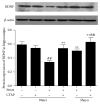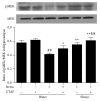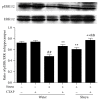Possible Involvement of µ Opioid Receptor in the Antidepressant-Like Effect of Shuyu Formula in Restraint Stress-Induced Depression-Like Rats
- PMID: 25821488
- PMCID: PMC4363683
- DOI: 10.1155/2015/452412
Possible Involvement of µ Opioid Receptor in the Antidepressant-Like Effect of Shuyu Formula in Restraint Stress-Induced Depression-Like Rats
Abstract
Recently μ opioid receptor (MOR) has been shown to be closely associated with depression. Here we investigated the action of Shuyu, a Chinese herbal prescription, on repeated restraint stress induced depression-like rats, with specific attention to the role of MOR and the related signal cascade. Our results showed that repeated restraint stress caused significant depressive-like behaviors, as evidenced by reduced body weight gain, prolonged duration of immobility in forced swimming test, and decreased number of square-crossings and rearings in open field test. The stress-induced depression-like behaviors were relieved by Shuyu, which was accompanied by decreased expression of MOR in hippocampus. Furthermore, Shuyu upregulated BDNF protein expression, restored the activity of CREB, and stimulated MEK and ERK phosphorylation in hippocampus of stressed rats. More importantly, MOR is involved in the effects of Shuyu on these depression-related signals, as they can be strengthened by MOR antagonist CTAP. Collectively, these data indicated that the antidepressant-like properties of Shuyu are associated with MOR and the corresponding CREB, BDNF, MEK, and ERK signal pathway. Our study supports clinical use of Shuyu as an effective treatment of depression and also suggests that MOR might be a target for treatment of depression and developing novel antidepressants.
Figures







Similar articles
-
Shuyu capsules relieve liver-qi depression by regulating ERK-CREB-BDNF signal pathway in central nervous system of rat.Exp Ther Med. 2017 Nov;14(5):4831-4838. doi: 10.3892/etm.2017.5125. Epub 2017 Sep 18. Exp Ther Med. 2017. PMID: 29201187 Free PMC article.
-
[Effects of shuyu ningxln recipe on the praxiology and the expressions of hippocampal BDNF and trkB of model rats with chronic stress-induced depression].Zhongguo Zhong Xi Yi Jie He Za Zhi. 2013 Mar;33(3):370-5. Zhongguo Zhong Xi Yi Jie He Za Zhi. 2013. PMID: 23713253 Chinese.
-
Control of stress-induced depressive disorders by So-ochim-tang-gamibang, a Korean herbal medicine.J Ethnopharmacol. 2017 Jan 20;196:141-150. doi: 10.1016/j.jep.2016.12.025. Epub 2016 Dec 15. J Ethnopharmacol. 2017. PMID: 27988398
-
Geniposide improves repeated restraint stress-induced depression-like behavior in mice by ameliorating neuronal apoptosis via regulating GLP-1R/AKT signaling pathway.Neurosci Lett. 2018 May 29;676:19-26. doi: 10.1016/j.neulet.2018.04.010. Epub 2018 Apr 4. Neurosci Lett. 2018. PMID: 29626654
-
The VGF-derived peptide TLQP62 produces antidepressant-like effects in mice via the BDNF/TrkB/CREB signaling pathway.Pharmacol Biochem Behav. 2014 May;120:140-8. doi: 10.1016/j.pbb.2014.03.003. Epub 2014 Mar 11. Pharmacol Biochem Behav. 2014. PMID: 24631486
Cited by
-
Behavioural and biochemical changes in maternally separated Sprague-Dawley rats exposed to restraint stress.Metab Brain Dis. 2016 Feb;31(1):121-33. doi: 10.1007/s11011-015-9757-y. Epub 2015 Nov 11. Metab Brain Dis. 2016. PMID: 26555398
-
The clinical application of Chinese herbal medication to depression: A narrative review.Front Public Health. 2023 Mar 9;11:1120683. doi: 10.3389/fpubh.2023.1120683. eCollection 2023. Front Public Health. 2023. PMID: 36969689 Free PMC article. Review.
-
Roles of the µ-opioid receptor and its related signaling pathways in the pathogenesis of premenstrual syndrome liver-qi stagnation.Exp Ther Med. 2017 Jun;13(6):3130-3136. doi: 10.3892/etm.2017.4374. Epub 2017 Apr 21. Exp Ther Med. 2017. PMID: 28587388 Free PMC article.
-
Treatment with Shuyu capsule increases 5-HT1AR level and activation of cAMP-PKA-CREB pathway in hippocampal neurons treated with serum from a rat model of depression.Mol Med Rep. 2018 Mar;17(3):3575-3582. doi: 10.3892/mmr.2017.8339. Epub 2017 Dec 22. Mol Med Rep. 2018. PMID: 29286104 Free PMC article.
References
LinkOut - more resources
Full Text Sources
Other Literature Sources
Research Materials
Miscellaneous

